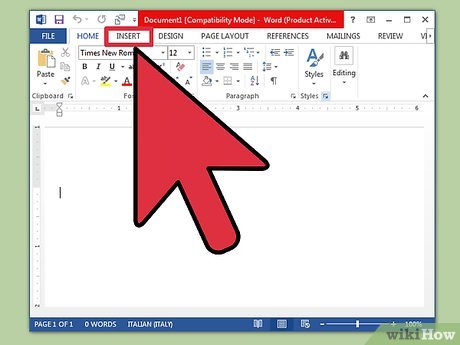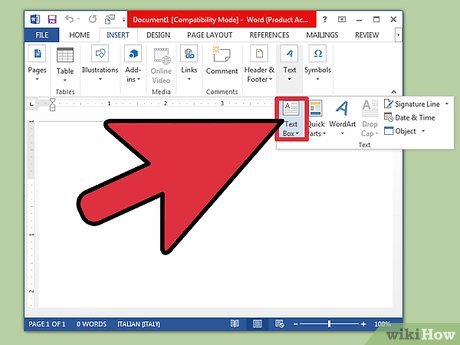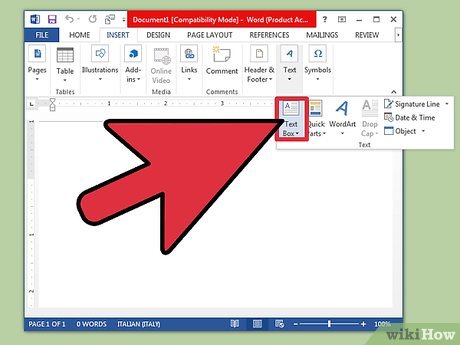How to Change the Orientation of Text in Microsoft Word
Method 1 of 3:
Writing Vertical Words
-
 Follow this method for horizontal letters in a vertical orientation. This method creates text with each letter of a word below the last, like a tall, narrow street sign. If you're trying to rotate the letters so you have to turn your head to read them, skip down to the other instructions.
Follow this method for horizontal letters in a vertical orientation. This method creates text with each letter of a word below the last, like a tall, narrow street sign. If you're trying to rotate the letters so you have to turn your head to read them, skip down to the other instructions. -
 Insert a text box. A text box makes it much easier to adjust the position and orientation of text. Add it to your Word document as follows:
Insert a text box. A text box makes it much easier to adjust the position and orientation of text. Add it to your Word document as follows:- Word 2007 or later: On the ribbon menu above your document, click the Insert tab, then Text Box, then Draw Text Box. Click and drag in the document.[1]
- Word for Mac 2011 or later: Select Home on the ribbon menu, then click Text Box on the right hand side. Click and drag in the document.
- Word 2003 / Word for Mac 2008 or earlier: Select Insert → Text Box from the top menu. Click and drag in the document.[2]
-
 Type in your text. Click the text box and type in the text you'd like to orient vertically. If you already typed it in to the document, copy and paste it into the text box.
Type in your text. Click the text box and type in the text you'd like to orient vertically. If you already typed it in to the document, copy and paste it into the text box. -
 Click the text box. A rectangular outline will appear around the text. Each corner of the box has a circle. These circles are "handles" you can pick up and drag to change the box size.
Click the text box. A rectangular outline will appear around the text. Each corner of the box has a circle. These circles are "handles" you can pick up and drag to change the box size. -
 Drag the corner of the text box. Click and hold on any corner of the text box, then move the cursor. Drag the corner to make the text box a tall, narrow shape. Once the box becomes too narrow to display two letters side by side, they will shift on top of each other instead.
Drag the corner of the text box. Click and hold on any corner of the text box, then move the cursor. Drag the corner to make the text box a tall, narrow shape. Once the box becomes too narrow to display two letters side by side, they will shift on top of each other instead.- If the box is rotating, or if it's moving without changing shape, you didn't click it right. Try again and make sure to click the corner of the box.
Method 2 of 3:
Rotating a Text Box (Word 2007 and later)
-
 Check your version of Word. This method covers Word 2007 or later on a Windows, and Word 2011 or later on a Mac. If you don't know your version number, here's an easy test: if there's a "ribbon menu" of icons above your open document, follow these instructions. If there's no ribbon menu skip to the next method instead.
Check your version of Word. This method covers Word 2007 or later on a Windows, and Word 2011 or later on a Mac. If you don't know your version number, here's an easy test: if there's a "ribbon menu" of icons above your open document, follow these instructions. If there's no ribbon menu skip to the next method instead.- If you only see a row of tabs labeled "Home," "Layout," etc., click on one of these tabs to expand the ribbon menu.
-
 Insert a text box. Click the Text Box button on the ribbon menu. This is under the Insert or Home tabs, depending on your version of Word.
Insert a text box. Click the Text Box button on the ribbon menu. This is under the Insert or Home tabs, depending on your version of Word. -
 Type in the text box. Click on the text box and type in the text you'd like to rotate. Notice that clicking on the text box makes a border appear.
Type in the text box. Click on the text box and type in the text you'd like to rotate. Notice that clicking on the text box makes a border appear. -
 Click the circle above the text box. Look for a line that extends above the border of the text box, ending in a circle. Click and hold this circle.
Click the circle above the text box. Look for a line that extends above the border of the text box, ending in a circle. Click and hold this circle. -
 Drag to rotate the box. Move your cursor while holding down on the circle to rotate the text box.
Drag to rotate the box. Move your cursor while holding down on the circle to rotate the text box.- After rotating, when you click the box to edit the text, it may snap back to the normal orientation. This is just to make it easier for you to see what you're doing. It should return to the position your chose after you click outside the box.
-
 Hold Shift for cleaner rotating. Hold down Shift while rotating to limit the possible positions. This makes it easier to rotate to even 45º or 30º angles, and to make parallel text boxes.
Hold Shift for cleaner rotating. Hold down Shift while rotating to limit the possible positions. This makes it easier to rotate to even 45º or 30º angles, and to make parallel text boxes. -
 Use menu options instead. If you're having trouble achieving the look you want, try rotating using menu commands instead:[3]
Use menu options instead. If you're having trouble achieving the look you want, try rotating using menu commands instead:[3]- Double-click the text box to open the Format ribbon menu, or select the Format tab.
- Click the Text Direction button in the ribbon menu. In some versions this is a small, unlabeled button with an image of vertical text.
- Select one of the options from the drop-down menu.
Method 3 of 3:
Rotating Text (Word 2003 and earlier)
-
 Check your version number. This method covers Word 2003 for Windows, Word 2008 for Mac, and all earlier versions.
Check your version number. This method covers Word 2003 for Windows, Word 2008 for Mac, and all earlier versions. -
 Insert a text box. Click on Insert in the toolbar and select Text Box from the drop-down menu. Click the box and type to enter text.
Insert a text box. Click on Insert in the toolbar and select Text Box from the drop-down menu. Click the box and type to enter text. -
 Move and resize the text box if necessary. Click and drag on the outside lines of the box to move it; click and drag on the blue circles and boxes to resize it.
Move and resize the text box if necessary. Click and drag on the outside lines of the box to move it; click and drag on the blue circles and boxes to resize it. -
 Click inside the text box. This will allow you to format the box separately from the rest of the document.
Click inside the text box. This will allow you to format the box separately from the rest of the document. -
 Click on Format in the toolbar and select Text Direction from the drop-down menu. A dialog box will pop up giving you the option to change the text orientation.
Click on Format in the toolbar and select Text Direction from the drop-down menu. A dialog box will pop up giving you the option to change the text orientation.- These older versions have inconsistent text rotation features.[4][5] If this doesn't work or you don't see the option, move on to the next step.
-
 Insert WordArt instead. Click Insert → Picture → WordArt on the top menu. Type in your text and select an art style.
Insert WordArt instead. Click Insert → Picture → WordArt on the top menu. Type in your text and select an art style.- You will not be able to edit this text, since it will turn into an image.
-
 Rotate the WordArt object. Click the image that was just created and a border will appear. Look above the top side of the border for a small line leading to a circle. Click and drag this circle to rotate the object.
Rotate the WordArt object. Click the image that was just created and a border will appear. Look above the top side of the border for a small line leading to a circle. Click and drag this circle to rotate the object.- Hold Shift while rotating to limit the available angles.
3.7 ★ | 3 Vote
You should read it
- How to Change the Volume on a Mac
- How to Copy and Paste on a Mac
- How to Change the Default Font on Windows 7
- How to fix Open with missing errors in the right-click menu
- How to Change the Color of Menu Buttons on a Mac
- 2 simple ways to remove SkyDrive Pro option in Windows 10 Right-click Menu
- How to Change How Long Until a Mac Asks for Your Password
- Add any applications to the right-click Windows Desktop Menu
May be interested
- How to change screen orientation in Windows 10
 in windows 10, you can change the screen orientation to horizontal, vertical, horizontal (flip backwards) or vertical (flip backward). this tutorial will show you how to change the screen orientation in windows 10.
in windows 10, you can change the screen orientation to horizontal, vertical, horizontal (flip backwards) or vertical (flip backward). this tutorial will show you how to change the screen orientation in windows 10. - Word 2016 Complete Guide (Part 3): Get familiar with basic text manipulation
 if you are new to microsoft word, you will need to learn more about the basics of how to enter, edit and organize text. basic operations include adding, deleting and moving text on your documents, and how to cut, copy and paste text.
if you are new to microsoft word, you will need to learn more about the basics of how to enter, edit and organize text. basic operations include adding, deleting and moving text on your documents, and how to cut, copy and paste text. - Lesson 22: Working with the Text Box
 you may want to insert a text box into your document to draw attention to a specific piece of text or allow you to easily move around the text in a document.
you may want to insert a text box into your document to draw attention to a specific piece of text or allow you to easily move around the text in a document. - Microsoft finally adds the Paste Text Only shortcut in Word
 after a long wait, microsoft word users will now have a new and much-needed keyboard shortcut that makes formatting text a lot easier.
after a long wait, microsoft word users will now have a new and much-needed keyboard shortcut that makes formatting text a lot easier. - Change the Section Break in Word 2007 and 2010
 when you want to change section break type in a word text, or simply manage the section better, change or reformat from the beginning ... how will you do it? maybe many people will think that the simple method is to delete that section, insert it to change the format ...
when you want to change section break type in a word text, or simply manage the section better, change or reformat from the beginning ... how will you do it? maybe many people will think that the simple method is to delete that section, insert it to change the format ... - How to use Spike to copy and paste text blocks in Word
 microsoft word has a little-known feature, called spike, but instead of storing pieces of paper, you can store blocks of text.
microsoft word has a little-known feature, called spike, but instead of storing pieces of paper, you can store blocks of text. - Quickly translate text using Microsoft Word 2003
 as you know, microsoft office suite is a powerful tool, in which the word processing program (ms word) is widely used. if you often edit english text, you probably can't ignore spelling, grammar or synonyms, left n
as you know, microsoft office suite is a powerful tool, in which the word processing program (ms word) is widely used. if you often edit english text, you probably can't ignore spelling, grammar or synonyms, left n - Multiple choice questions about Microsoft Word 2010 have a P2 answer
 word 2010 is a very useful microsoft text editor. with significant improvements, users will get a lot of interesting experiences with text editing. please join the network administrator to learn about this topic through multiple choice questions.
word 2010 is a very useful microsoft text editor. with significant improvements, users will get a lot of interesting experiences with text editing. please join the network administrator to learn about this topic through multiple choice questions. - Word 2013 Complete Guide (Part 18): How to insert Text Box and WordArt
 the text box text box can be useful in attracting readers' attention to specific texts. please refer to how to insert text box and wordart in word 2013!
the text box text box can be useful in attracting readers' attention to specific texts. please refer to how to insert text box and wordart in word 2013! - Copy and move text in MS Word with F2 key
 this quick tip is useful for users of microsoft word word processing versions 2007 and 2013, which helps to move and copy more efficiently with the f2 shortcut on the keyboard. to perform the cut and paste operation without using the right mouse button or the combination of traditional ctrl-x and ctrl-v keyboard shortcuts, you can mark a block of text or images you want to cut in word and then press the key f2.
this quick tip is useful for users of microsoft word word processing versions 2007 and 2013, which helps to move and copy more efficiently with the f2 shortcut on the keyboard. to perform the cut and paste operation without using the right mouse button or the combination of traditional ctrl-x and ctrl-v keyboard shortcuts, you can mark a block of text or images you want to cut in word and then press the key f2.
























 How to Turn a Scanned Document Into Microsoft Word Document
How to Turn a Scanned Document Into Microsoft Word Document How to Merge Documents in Microsoft Word
How to Merge Documents in Microsoft Word How to Remove a Blank Page in Word
How to Remove a Blank Page in Word How to Check a Word Count in Microsoft Word
How to Check a Word Count in Microsoft Word How to Insert a Line in Word
How to Insert a Line in Word How to Wrap Text in Word
How to Wrap Text in Word